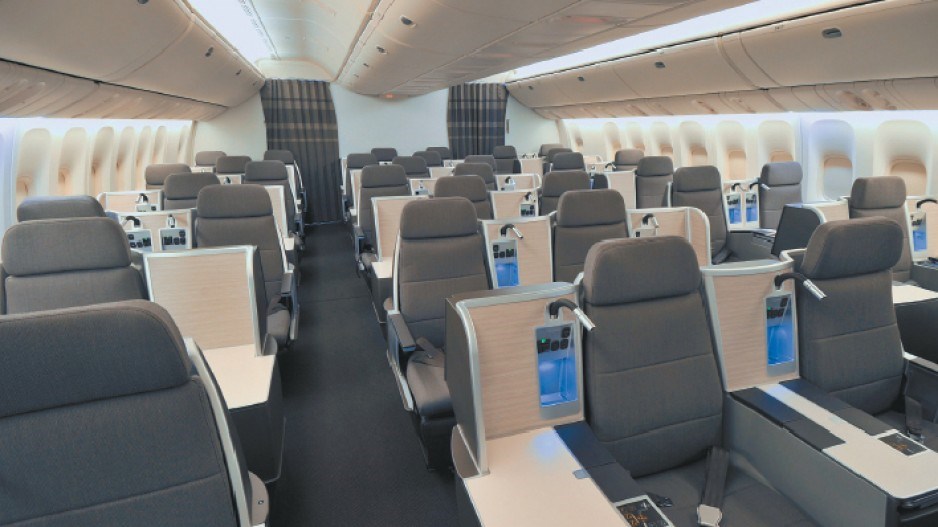The CEO of Canada's largest airline has come out swinging against Vancouver Airport Authority CEO Craig Richmond's drive to convince Ottawa to negotiate less restrictive air agreements so more carriers can fly in and out of Vancouver International Airport (YVR).
"We don't support and we will continue to not support that," Air Canada (TSX:AC.B) president and CEO Calin Rovinescu told Business in Vancouver during an exclusive interview.
Richmond last month told BIV ("Flight plans" – BIV profile; issue 1252; October 22-28) that his top priority was to convince the federal government to negotiate freer air agreements with the United Arab Emirates (UAE), Thailand and countries in South America to secure more direct flights to and from YVR and increase air traffic through the airport.
But Rovinescu opposes air agreements that let carriers in countries with small populations fly directly to Canada because he fears his airline would lose passengers to competition yet not find it viable to fly the same route.
In 2010, when Emirates Airline sought to expand its thrice-weekly Toronto-Dubai service and launch a Vancouver-Dubai route, Air Canada opposed the move, arguing that Emirates would pick up passengers from Canada and take them to third countries using Dubai as a stopover.
That would mean a loss of passengers for Canadian airlines without any reciprocal gain from new passengers coming from Dubai.
In the end, the Canadian government did not liberalize its air agreement with UAE, and Emirates launched a Dubai-Seattle route in March 2012.
"When the UAE gets more liberalized agreements with countries around the world, it typically has damaged the domestic market," Rovinescu said.
"In Australia, it diminished Qantas significantly. In the case of New Zealand, it significantly diminished the capabilities of Air New Zealand. In the case of India, the same thing."
But Rovinescu said some "open skies" agreements make sense.
He likes air agreements with larger markets, such as the U.S., European Union, Japan and Korea, because those regions have large enough domestic populations for Air Canada to schedule direct routes.
"When you deal with open skies agreements, you are dealing with trade agreements. [It's] not unlike softwood lumber or the debate over beef or over dairy. That's essentially what this is."
Rovinescu added that protectionism is warranted because foreign carriers would "cherry pick" routes and divert traffic from Air Canada.
Indeed, losing passengers on the Vancouver-Seoul route was part of the rationale when Air Canada opposed Singapore Airlines' 2007 request to increase its thrice-weekly flights between Singapore and Vancouver via Seoul, Korea. That opposition spurred Ottawa to reject Singapore Airlines' request, prompting the airline to stop flying out of YVR in April 2009.
Richmond agreed with Rovinescu that air agreements are essentially trade pacts, but he said that's why they should be loosened.
"I don't mind being traded and being bartered around like oranges," he told BIV. "I've got to be in the basket."
Rovinescu will be in Vancouver speaking to the Vancouver Board of Trade on November 13.
In-flight Wi-Fi: Coming soon to an airplane near you
Regulatory hurdles and an uncertain business case have thus far prevented Wi-Fi from being available on Canadian domestic flights, but that could change soon.
American Airlines Inc. (OTC US:AAMRQ), Delta Air Lines Inc. (NYSE:DAL) and United Continental Holdings Inc. (NYSE:UAL) have been fast adopters south of the border, signing contracts with Internet providers so they can offer customers in-flight Wi-Fi.
Air Canada (TSX:AC.B) has tiptoed into the game. Company president and CEO Calin Rovinescu told Business in Vancouver the airline has equipped two of its planes with Wi-Fi for its Toronto–San Francisco and Toronto–Los Angeles flights.
He added that enabling Wi-Fi on domestic flights would need changes in Transport Canada regulations and could require potentially costly upgrades to planes.
"You're taking airplanes out of service to install [Wi-Fi capability]," he said. "It sounds good on paper, but the question is once you've installed it on an airplane, is it something that people will pay for at an adequate level of return for the investment?"
Airlines sign agreements with providers such as Gogo Inc. (Nasdaq:GOGO), Panasonic Corp., Row 44 or OnAir for the ability to offer in-flight Wi-Fi.
Those providers then set prices.
The largest provider of in-flight Internet, Chicago-based Gogo, for example, charges $14 for a day pass and $50 for a monthly pass.
It estimates that 6% of passengers currently pay for in-flight Wi-Fi that functions when the plane flies above 10,000 feet.
Gogo has partnered with Ottawa's SkySurf to provide Wi-Fi service on flights in Canadian airspace.
SkySurf paid a reported $2.1 million to the federal government at a 2009 wireless spectrum auction for the right to provide ground-to-sky Internet.
"Wi-Fi is a great tool that I personally enjoy using when I have access to it in the air," Rovinescu said, "but it's about establishing a business model that works."
Air Canada considers direct flights between Vancouver and India
When Air Canada (TSX:AC.B) receives six Boeing 787 Dreamliners next year, it plans to base at least one of the planes in Vancouver, Rovinescu told BIV.
"With the Dreamliner, you could have the right number of seats for a route such as Vancouver to India. So, India will be one of the routes we'll be studying."
Vancouver Airport Authority's director of aviation marketing, John Korenic, has been trying to convince various carriers for years that direct Vancouver-India flights make economic sense.
At least four Dreamliners have had electrical system problems caused by the plane's lithium-ion batteries in the year following their 2012 launch.
But airlines covet the planes because they can fly direct anywhere on the globe. They also have lower fuel and maintenance costs than conventional planes.




